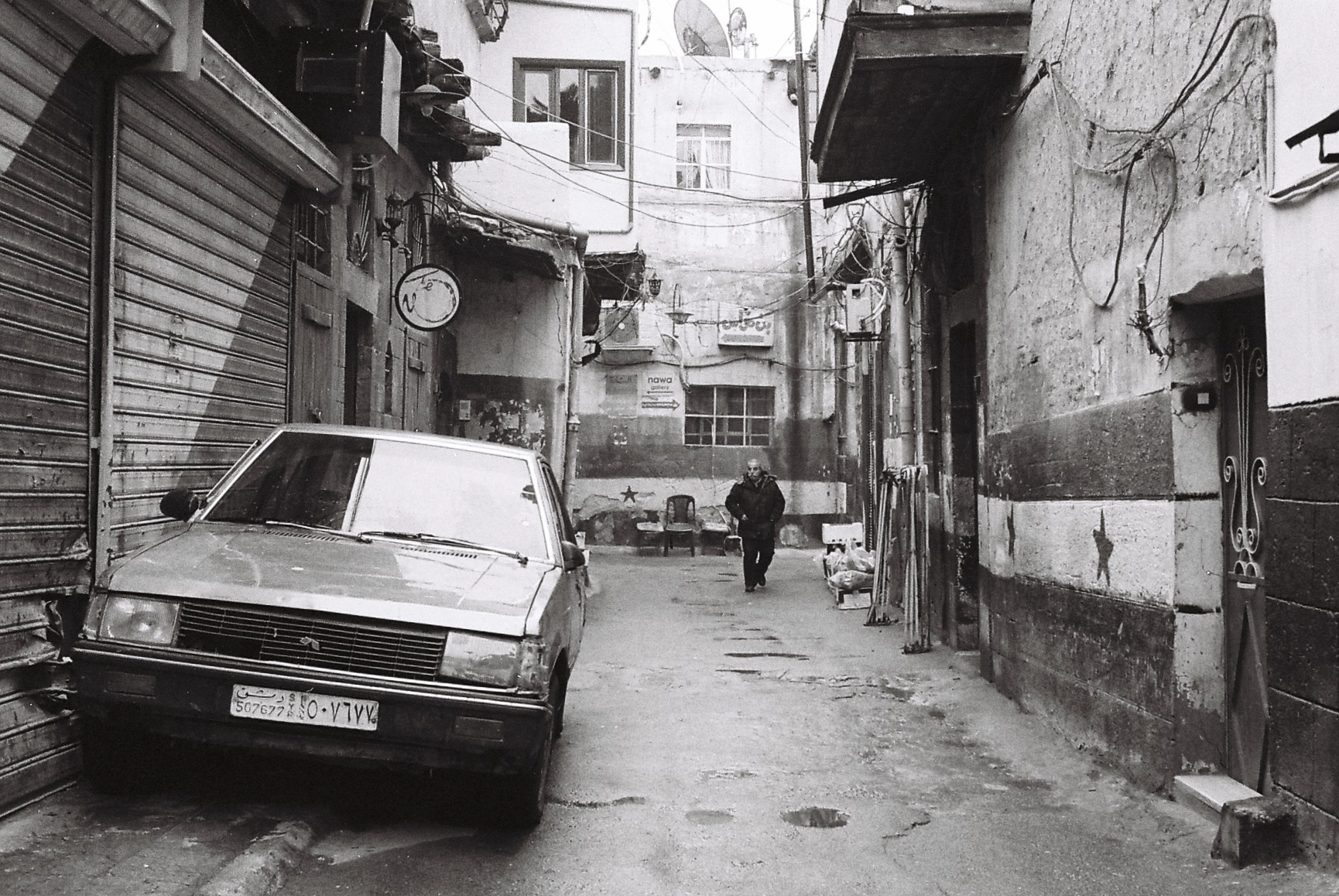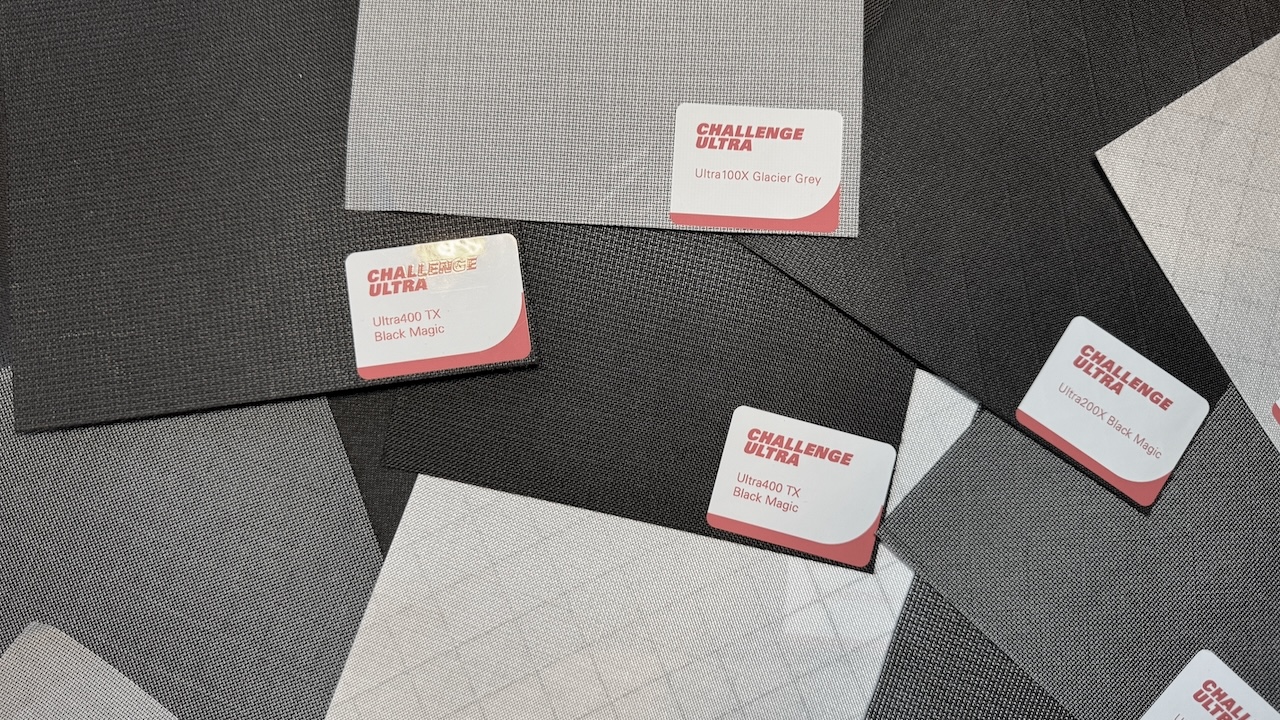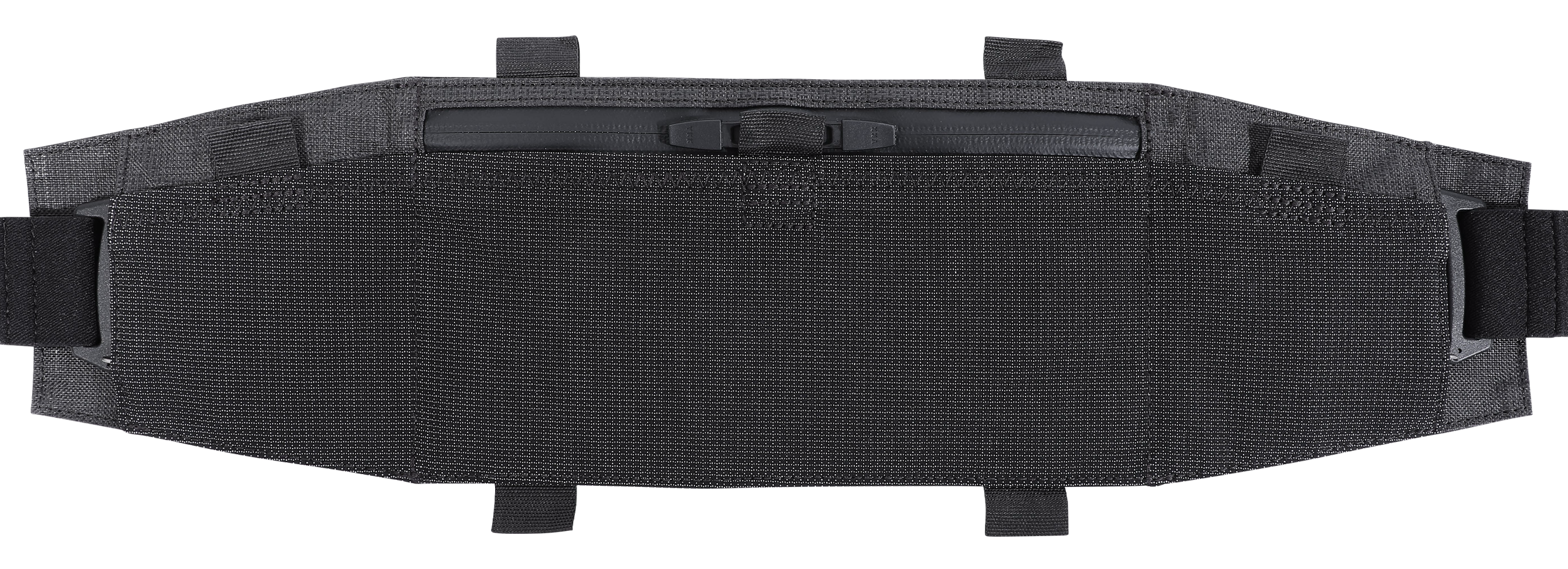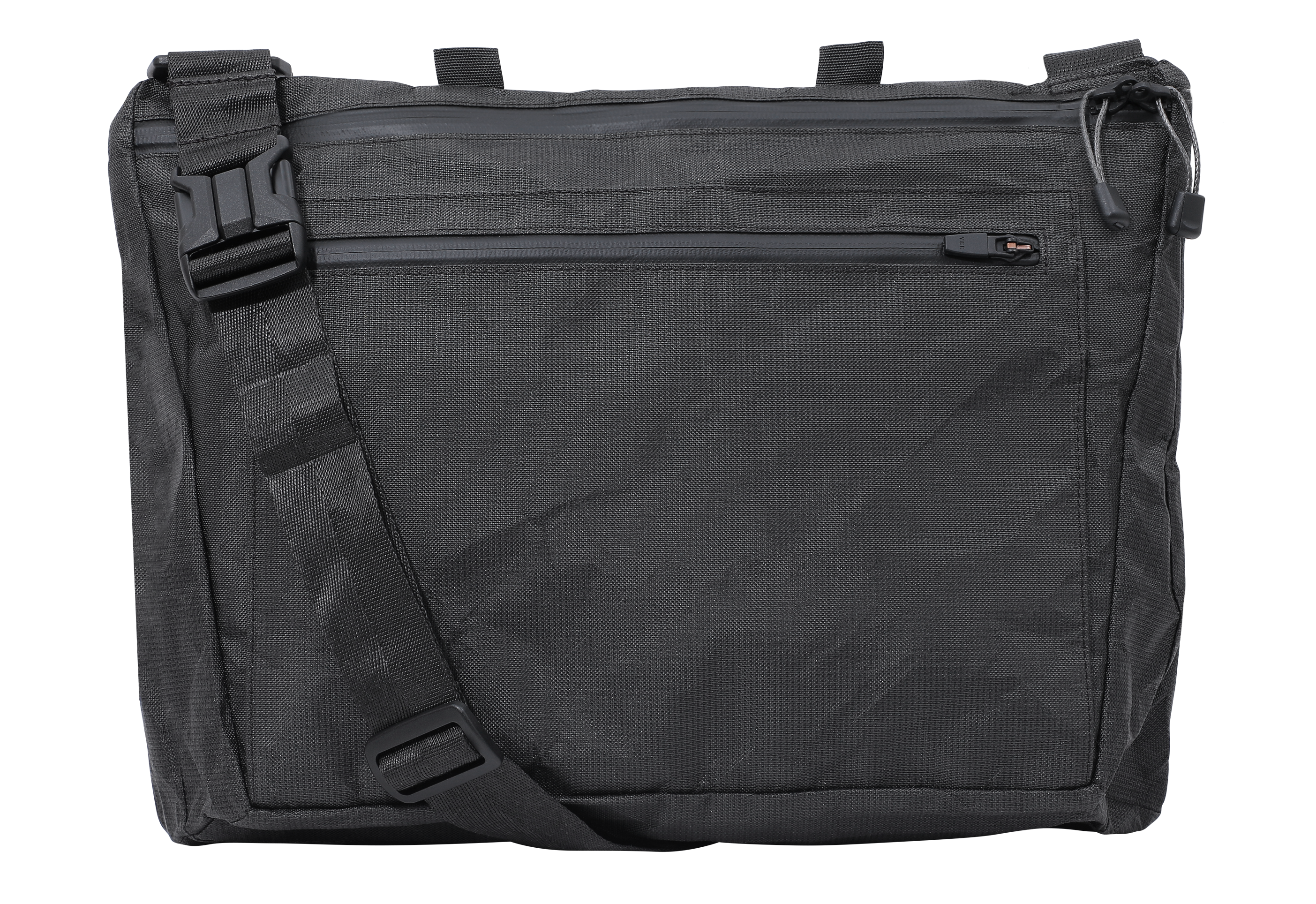Materials
We carefully select materials based on their capability to endure adverse environments and situations.

The back streets of Damascus, Syria
Fabric
We tested more than a dozen fabrics during design and prototyping, including Cordura, HyperD, Robic Ripstop Nylon, X-Pac, Dyneema Composite Fabric (DCF), and others. The best material we came across is made by Challenge Outdoor. Right now, the Challenge UltraWeave line of fabrics is the highest performing UHMWPE composite fabric available. It’s perfect for our bags and accessories.
We’ve avoided using the lightest weight materials, because they won’t feel strong enough (even though they probably are). The problem with using ultra-light materials is that you’ll always be worried about damaging your bag. You’ll also worry that anything you store in your bag could be broken if you drop the bag.
We don’t just want our bags to be durable. We want them to feel durable.
Our testing has shown that UltraWeave 400X provides the best balance of weight, strength and durability.

Challenge fabric samples used during material selection
Challenge UltraWeave
We’ve selected Challenge UltraWeave 400X fabric for most of our bags. For the Street Tote, because it’s reversible, we’re using Challenge UltraWeave 200X for the inner and outer layers.
UltraWeave is constructed using a blend of UHMWPE and high-tenacity polyester. The face fabric comprises a mix of 67% UHMWPE fibre and 33% polyester fibre. The tight weave is laminated with an eco-friendly adhesive to Challenge RUV film. The result is a textile that is incredibly strong, lightweight, and waterproof to 200 psi. The fabric is highly resistant to abrasion, cuts and tears. It’s also resistant to UV and chemicals. It performs well in the harshest environments, in both sub-zero and tropical climates.
For our Street Series and Travel Series ranegs, we’ve found that UltraWeave 400X provides a good balance of strength, weight and durability. It’s about 20% lighter and four times more abrasion resistant than other 400d U-PE fabrics. We’re also using UltraWeave 200X for some applications.
UltraWeave wears nicely. Over time, you’ll find that the material develop an appealing aged look without losing any of its advanced properties.
Challenge UltraStretch
We’re using Challenge UltraStretch fabric for all internal and external elasticised pockets.
UltraStretch is a woven blend of Nylon 6-6, Lycra, and Ultra-PE. The fabric has 4-way stretch, and is lightweight, durable, and tear-resistant. It’s also coated with C6 DWR, making it water resistant.

Challenge UltraStretch used for the outer pockets of the Street Belt
About UHMWPE
Ultra-High Molecular Weight Polyethylene (UHMWPE or U-PE) fibres are the lightest and strongest fibres commercially available, with a tensile strength 15x stronger than steel. For those of you familiar with Dyneema® or Spectra®, UHMWPE is the non-branded version of this material.
UHMWPE fibres have a very high strength-to-weight ratio. They are highly resistant to cutting and abrasion, making the fabric very durable. UHMWPE is also highly resistant to UV rays, moisture, and chemicals.
In the context of making durable bags, UHMWPE will outperform nylon and polyester in most contexts.
Water Resistance
UHMWPE is highly water-resistant and does not absorb water. This property ensures that UHMWPE maintains its strength even when exposed to wet conditions, making it an excellent choice for use in wet environments.
Humidity Resistance
UHMWPE is highly resistant to moisture and humidity. Unlike nylon, UHMWPE does not absorb water, which can weaken the material.
Sunlight and UV Resistance
UHMWPE has excellent resistance to sunlight and UV radiation. It does not degrade or weaken as quickly when exposed to UV rays compared to nylon, which can degrade over time when exposed to prolonged sunlight.
Cold Resistance
UHMWPE retains its strength and flexibility in cold conditions, making it suitable for use in cold climates. It is often more cold-resistant than nylon, which can become brittle in freezing temperatures.
The only downside of UHMWPE is that it has a lower melting point than nylon and polyester. So don’t place your Station XV bags next to a fire.
If it’s so good, why isn’t everyone using it? The key reason is that it’s very expensive. UltraWeave fabrics sell for between $30 - $35 per yard, which is 5 to 6 times more expensive than nylon and polyester pack materials.
Difference Between UltraWeave and Dyneema Composite Fabric (DCF)
Challenge UltraWeave gets its strength and abrasion resistance from the blended UHMWPE/Polyester face fabric and has the addition of bias UHMWPE reinforcing fibres to keep the materials stable and bonded to their backing film well. DCF gets its strength from a layer of thinly spread Dyneema fibres. This layer is protected by a thin, not very abrasion resistant 150d poly fabric. The inner fibres are non-woven and can be separated if snagged.
Internal Organisation and Lining
We’ve selected Challenge EPX300RS for internal organisation panels in the Street Pack and Street Satchel.
We use Challenge EPX70RS for lining the top panels of the Street Pack and for the internal organisation of the Travel Folio.
EPX fabrics are part of Challenge’s ECOPAK™ range, and are made from 100% recycled polyester components. the fabric has a C0 DWR (no fluorocarbons), and has a 70d Ripstop backing for added strength.
ECOPAK fabrics are mostly woven in Thailand and laminated at a factory in China.
Zippers
We’ve selected YKK zips across our range of bags and accessories.
These zips have been customised to our specifications.
We’re using #8 racquet coil zips for the main access zips on most bags. Racquet coil zips are more durable and resistant to the elements than standard coil zips, allowing for smooth operation. We use a lockable slider on this zip, allowing you to secure your bag with a travel lock or zip tie. The zip pulls are made from 2mm UHMWPE cord manufactured to our specifications. These zip pulls have been designed to allow for easy operation of the zip even when wearing gloves. The zip pulls are also user replaceable.
For organiser pockets and accessory pouches, we’re using #5 coil zips. The #5 zip slider is a locking slider, and the pull tab folds flat against the bag when not in use.
Our zips have been customised by YKK to include recycled polyester tape in a reverse deployment. This tape has been coated with a matte black PU coating. This coating provides additional water resistance to the zip and blends nicely with the texture of the UltraWeave material.
Both the #8 and #5 zip sliders have been customised in a matte black oxide finish. The black oxide coating doesn’t chip. Over time, however, these sliders will wear gently to develop a pleasant ‘brassed’ patina.

Customised matte black PU zippers and matte black oxide zip sliders on the Street Satchel
Webbing
Working directly with a webbing manufacturer, we’ve developed customised UHMWPE webbing.
For the equivalent width, thickness and weave, UHMWPE webbing is typically five times as strong as nylon or polyester webbing and is significantly more resistant to abrasion and humidity. UHMWPE webbing doesn’t absorb water and maintains its properties when wet or frozen.
We’re using different types of webbing for different purposes.
For webbing sewn onto the bags, we’re using 1.0 mm UHMWPE webbing in a mil-spec 17337 weave. The thickness and weave of this webbing maximises strength and prevents unwanted slippage through components.
For straps and handles, we’re using 1.0 mm UHMWPE webbing in either a mil-spec 17337 or herringbone weave. The herringbone weave is a very fine weave that’s comfortable in the hand.
For accessory tabs and attachment points, we’re using 0.6 mm UHMWPE webbing in a plain weave.
For binding of load bearing seams, we use 0.6 mm UHMWPE webbing in a plain weave. Using UHMWPE in combination with our high-tenacity thread maximises seam strength and durability. For other binding, we use polyester binding tape.
Components
We’ve selected high quality acetal components across our range of bags. Acetal (POM) performs better than nylon in different temperature and humidity ranges. As it doesn’t absorb water, it remains unaffected by prolonged exposure to water or humidity. Acetal is also not affected by ‘plasticizer migration’, which can make plastic components feel sticky over time.
Plastic components might degrade over time and could break. A key feature of our designs is that there are no components fixed to the bags. Instead, we’ve attach components to the slings, handles and straps. That way, if you have a problem with a component, you can just replace the strap without needing to repair or replace the bag.
The other benefit of this approach is that you can customise your own straps.
Thread
There’s no point in us using the most advanced materials available if we don’t also optimise our approach to construction.
We’re using a specialised thread made from high tenacity continuous filament polyester with an innovative bonding technology. This thread has been specifically designed for demanding applications. This thread has 20 – 33% higher retained strength compared with other standard lubricated sewing threads leading to less seam breaks.
We use semi flat felled seams for key load bearing seams. Where appropriate, we use a second row of stitching for reinforcement.
To top it off, we use 0.6mm UHMWPE webbing as binding material to reinforce load bearing seams.
Where webbing is sewn onto the face of the UltraWeave fabric, we include a layer of 38mm x 0.6mm UHMWPE webbing behind the face fabric to reinforce the stitching and reduce the likelihood of the fabric tearing.
Not quite bomb proof, but close.
More details of how we apply different materials in each bag are provided on the respective product pages.
View our products